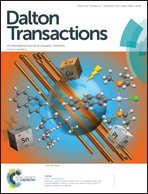A combined kinetico-mechanistic and computational study on the competitive formation of seven- versus five-membered platinacycles; the relevance of spectator halide ligands†
Abstract
The metalation reactions between [Pt2(4-MeC6H4)4(μ-SEt2)2] and 2-X,6-FC6H3CH![[double bond, length as m-dash]](https://www.rsc.org/images/entities/char_e001.gif) NCH2CH2NMe2 (X = Br, Cl) have been studied. In all cases, seven-membered platinacycles are formed in a process that involves an initial reductive elimination from cyclometallated PtIV intermediate compounds, [PtX(4-CH3C6H4)2(ArCH
NCH2CH2NMe2 (X = Br, Cl) have been studied. In all cases, seven-membered platinacycles are formed in a process that involves an initial reductive elimination from cyclometallated PtIV intermediate compounds, [PtX(4-CH3C6H4)2(ArCH![[double bond, length as m-dash]](https://www.rsc.org/images/entities/char_e001.gif) NCH2CH2NMe2)] (X = Br, Cl), followed by isomerization of the resulting PtII complexes and a final cyclometallation step. For the process with X = Br, the final seven-membered platinacycle and two intermediates, isolated under the conditions implemented from parallel kinetic studies, have been characterized by XRD. Contrary to previous results for the parent non-fluorinated imine 2-BrC6H4CH
NCH2CH2NMe2)] (X = Br, Cl), followed by isomerization of the resulting PtII complexes and a final cyclometallation step. For the process with X = Br, the final seven-membered platinacycle and two intermediates, isolated under the conditions implemented from parallel kinetic studies, have been characterized by XRD. Contrary to previous results for the parent non-fluorinated imine 2-BrC6H4CH![[double bond, length as m-dash]](https://www.rsc.org/images/entities/char_e001.gif) NCH2CH2NMe2 the presence of a fluoro substituent prevents the formation of the more stable five-membered platinacycle. Temperature and pressure dependent kinetico-mechanistic and DFT studies indicate that the final cyclometallation step is strongly influenced by the nature of the spectator halido ligand, the overall reaction being much faster for X = Cl. The same DFT study conducted on the previously studied systems with imine 2-BrC6H4CH
NCH2CH2NMe2 the presence of a fluoro substituent prevents the formation of the more stable five-membered platinacycle. Temperature and pressure dependent kinetico-mechanistic and DFT studies indicate that the final cyclometallation step is strongly influenced by the nature of the spectator halido ligand, the overall reaction being much faster for X = Cl. The same DFT study conducted on the previously studied systems with imine 2-BrC6H4CH![[double bond, length as m-dash]](https://www.rsc.org/images/entities/char_e001.gif) NCH2CH2NMe2 indicates that, when possible, five-membered platinacycles are kinetically preferred for X = Br, while the presence of Cl as a spectator halido ligand leads to a preferential faster formation of seven-membered analogues.
NCH2CH2NMe2 indicates that, when possible, five-membered platinacycles are kinetically preferred for X = Br, while the presence of Cl as a spectator halido ligand leads to a preferential faster formation of seven-membered analogues.



 Please wait while we load your content...
Please wait while we load your content...